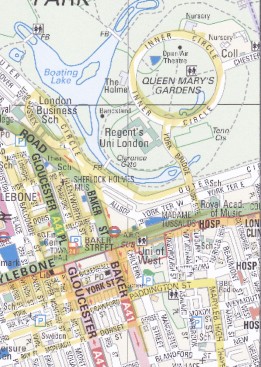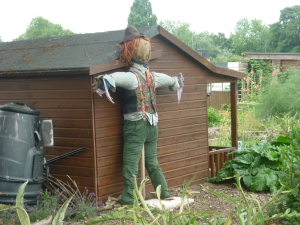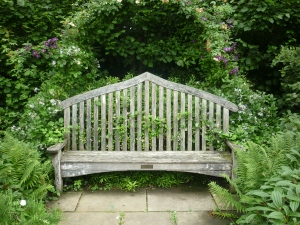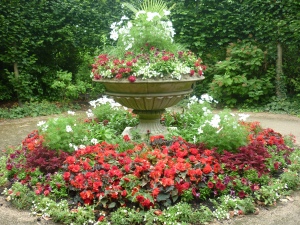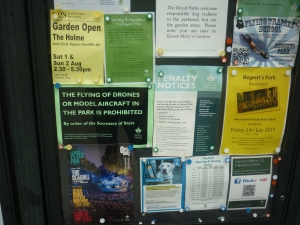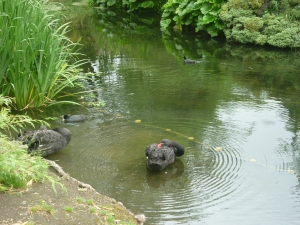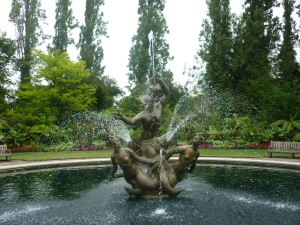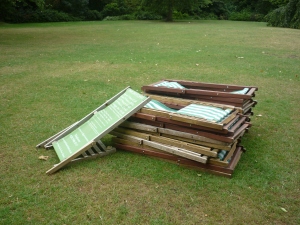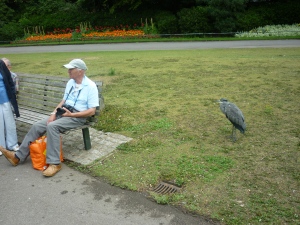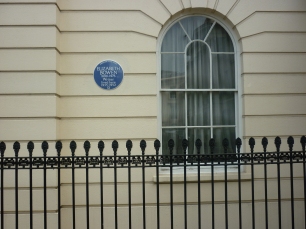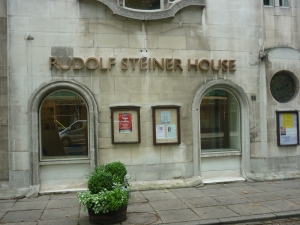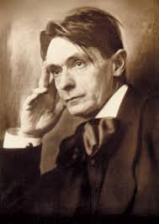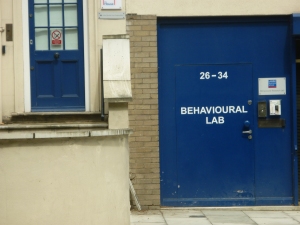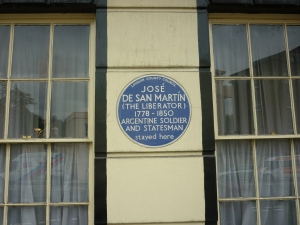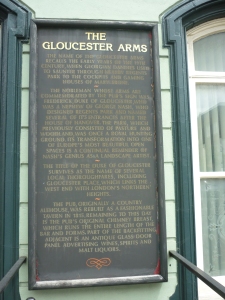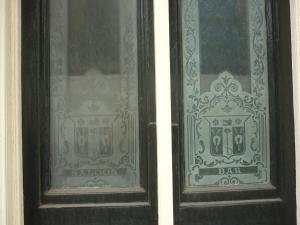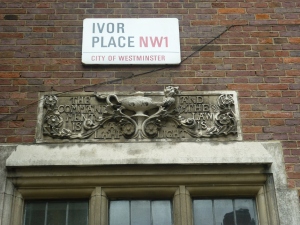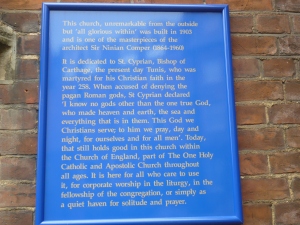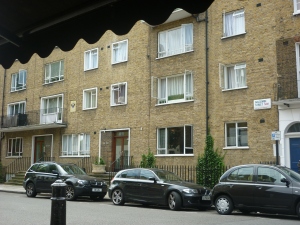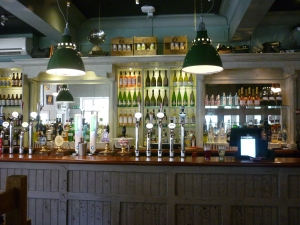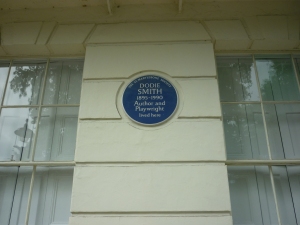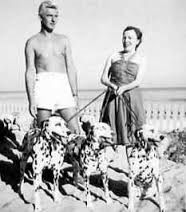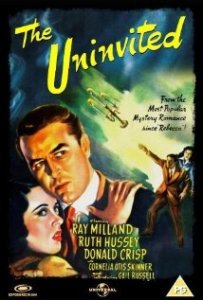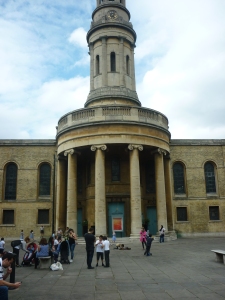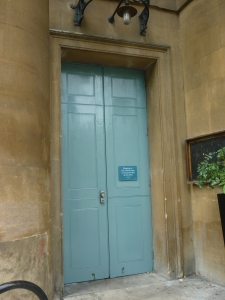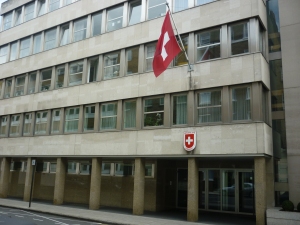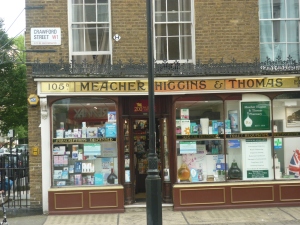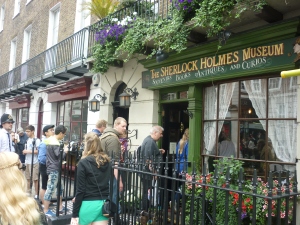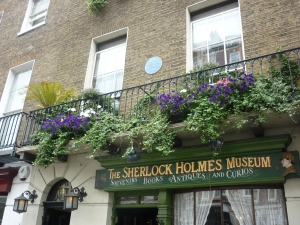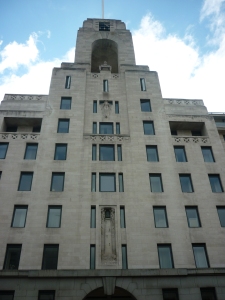Today’s excursion is primarily concerned with the triangular area formed drawing a line along the Marylebone Road from Baker Street tube to the junction with the Edgware Road then down the latter to Marble Arch and back across to where you started. After completing that there was just time to hop over to the west side of Edgware Road a do a few streets to the north of Hyde Park. Looking at this map, it just (finally) occurred to me how much easier this same project would be in Manhattan where the streets are all numbered and laid out in a nice symmetrical grid.

We start out today on the Marylebone Road again, outside Old Marylebone Town Hall. This was designed by Sir Edwin Cooper (1874 – 1942), who also designed the impressive Port of London Authority building in Trinity Square, and opened in 1920. The building was listed in 1981 and in 2013 it was acquired from Westminster City Council by the London Business School. Following a redevelopment programme that involved the creation of a new glass and steel entrance structure linking the Town Hall building with its annexe, the Sammy Ofer Centre (named after £25m donor Idan Ofer) opened for, well, business in 2018. The main building continues to function as Westminster Registry Office in which capacity it has historically proved very popular with both members of the Beatles and wanna-be members of the Beatles. Paul McCartney has got hitched here twice; to Linda in 1969 and then for the third time, to Nancy Shevell in 2011 (I have to admit that that one passed me by). Ringo and Barbara Bach also tied the knot here as did Liam Gallagher and Patsit Kensit (of course they did) and Antonio Banderas and Melanie Griffiths.
Moving past the Town Hall we turn left into Upper Montagu Street then work our way back to the Marylebone Road via Salisbury Place, Thornton Place, York Street and Knox Street. Sandwiched between the latter and Wyndham Street is the suitably low-key London HQ of Philip Green’s Arcadia businesses. I guess these days it’s somewhat stretching a point to call it an empire.

Down Wyndham Street to York Street again then back up Enford Street which emerges opposite the Landmark Hotel; which we covered last time out but not with an accompanying picture of the whole building so here it is in all its splendour.

Back on the south side is the Grade II listed but derelict building that started out as the Free Hospital for Women and Children and Samaritan Institution when constructed in 1889. Fifteen years later it was renamed (slightly more snappily) as the Samaritan Free Hospital for Women. After becoming part of the NHS in 1948 it survived for almost a further 50 years until it closed in 1997.

Opposite, and somehow I missed this last time, is what remains of St Marylebone Grammar School. The school was founded in 1792 under the name of the Philological Society by Thomas Collingwood, under the patronage of the Prince Frederick, second son of George III, with the aim of helping “the heads of families, who by unexpected misfortune, have been reduced from a station of comfort and respectability.” It moved to Marylebone Road in 1827 and was accepted in trust by the London County Council in 1908 and renamed St Marylebone Grammar School. During the early Seventies SMGS was subject to a tug of war between the Labour controlled ILEA, who wished to merge it with a local secondary modern school, and the Conservatives who ran Westminster Council who didn’t. When Labour took over the Council in 1974 the Parents’ Association continued opposition to the scheme but in the end the ILEA simply refused to continue funding the school beyond 1981 and it was forced to close. Today the listed main original building forms part of the Abercorn independent prep school. Alumni of SMGS include pop star Stuart Goddard (aka Adam Ant), footballer John Barnes and writer Jerome K. Jerome
Continuing west the next left turning off of Marylebone Road is Seymour Place. Just round the corner the Rwandan High Commission is the first of four HCs we’ll encounter today.

Returning to York Street we switch eastward and then cut through Wyndham Place to Crawford Street. This is the site of St Mary’s Church which was built as one of the Commissioners’ churches in 1823–1824 and was designed by Robert Smirke (1780 – 1867) who was also responsible for the main block and façade of the British Museum.

From Crawford Street we loop back up to Harcourt Street which runs on a diagonal north-west to Old Marylebone Road and is home to the Swedish Church (Svenska Kyrkan), otherwise known as Ulrika Eleonora Church, which dates back to 1912.

For our final visit (for today) to the Marylebone Road we stroll westward in the shadow of the heavenly vision that is the Marylebone Flyover. As the plaque proclaims, the flyover was opened by Mr Desmond Plummer, leader of the Greater London Council, on 12th October 1967. 119m long and 17m wide it is crossed by around 80,000 vehicles each day. It was created as part of a proposed series of 1960s congestion-relieving initiatives forming the eastern end of the Westway elevated dual carriageway, one of the few schemes that actually came to fruition.

Turning south on the Edgware Road we make an immediate left into Chapel Street where we find the second of the two tube stations named after the Edgware Road. This one serves the Circle, District and Hammersmith & City lines and was opened as part of the Metropolitan Railway between Paddington and Farringdon in 1863.

At the end of Chapel Street we cross over the Old Marylebone Road and follow Homer Street down to Crawford Street. Running parallel to this, back up to the OMR, is Homer Row where T.S. Eliot (1888 – 1965) once resided. American born poet and playwright Thomas Stearns Eliot moved into 18 Crawford Mansions with his wife, Vivienne, in 1916, shortly after the publication of The Love Song of J. Alfred Prufrock. At the time, Eliot was working as a teacher at Highgate School where he taught a young John Betjeman. He also wrote book reviews and lectured in the evenings at University College London to earn extra money. By 1920 the couple had managed to find accommodation close to Regent’s Park that was both more capacious and less insalubrious in its surroundings. Today two bedroom apartments in Crawford Mansions sell for more than £1m.

Transept Street and Cabbell Street which both cross between OMR and Chapel Street are the settings for the impressive crimson-hued Oxford and Cambridge Mansions which date from 1885.

These buildings seem a world apart from the chaos and exoticism of the Edgware Road with its shisha cafes and mobile phone/money transfer outlets. One of the few relics of bygone days is Robertsons Pawnbrokers at 199 on the west side. Established in 1797, Robertsons specialises in fine, pre-owned, jewellery, gold, diamonds, watches, antiques and silver, and artwork and since the 1960s has been part of Suttons & Robertsons, one of the largest pawnbrokers in the UK.

Crawford Place takes us east back to Crawford Street which is one side of the square that surrounds the Seymour Leisure Centre, the others being Seymour Place, Bryanston Place and Shouldham Street. Grade II listed Seymour Leisure Centre was originally built in 1935-37 as a public baths and laundry by architect Kenneth Cross for St Marylebone Borough Council. The building is faced in purple brick with red brick architraves and Portland stone dressings and the gabled roof is clad in Spanish tiles. One of very few public sports facilities in central London, SLC boasts a gym, sports hall, 30m pool and an indoor climbing wall.

Besides Shouldham Street there are three more streets that bridge across from Crawford Place to Harrowby Street; Molyneux Street, Cato Street and Brendon Street. Opposite the start of Molyneux Street is 45 Crawford Place which is shared by the High Commissions of Belize and of Antigua & Barbuda and the street itself is home to the High Commission of Tonga.
Of much greater interest though is Cato Street, not that you would know it to look at it. For here it was that the perpetrators of the eponymous Cato Street Conspiracy met in 1820 to hatch their plot to assassinate Prime Minister, Lord Liverpool and all the members of his cabinet. The conspirators, enraged by the Peterloo Massacre and the repressive legislation enacted in its wake, styled themselves as the “Spencean Philanthropists” after the radical speaker Thomas Spence (1750 – 1814). They were led by Arthur Thistlewood, who had been involved with the Spa Fields riots of 1816, with George Edwards as his second in command. The conspirators planned to assassinate the cabinet while they were at a dinner hosted by Lord Harrowby. They would then seize key buildings, overthrow the government and establish a “Committee of Public Safety” to oversee a radical revolution. Unfortunately, this supposed dinner was a set-up courtesy of Edwards who, it transpired, was a government spy.
At 7:30 pm on the evening of February 23 the Bow Street Runners stormed the Cato Street hideout. Some conspirators surrendered peacefully, while others resisted forcefully, Thistlewood killing one of the police officers with a sword. He along with three others slipped out through the back window but they were arrested a few days later. During the trial, the defence argued that the statement of Edwards was unreliable and he was therefore never called to testify. Police did however persuade two of the men, Robert Adams and John Monument, to testify against other conspirators in exchange for dropped charges. Accordingly, most of the accused were sentenced to be hanged, drawn and quartered for high treason. All sentences were later commuted to either hanging and beheading or transportation for life. Thistlewood, Richard Tidd, James Ings, William Davidson and John Brunt were hanged at Newgate Prison on the morning of 1 May 1820.
On the stretch of the Edgware Road between the intersections with Harrowby Street and Nutford Place is a branch of Waitrose which occupies a former Woolworths store that first opened in 1914 but was done up in the modernist style seen below in 1936.

On the actual junction with Nutford Place this forlorn and faded pub sign presents a telling juxtaposition of the past and present of this area.

After a quick nod to Forset Street we proceed east on Nutford Place as far as Brown Street where we turn north. Off Brown Street is the pretty nondescript cul-de-sac of Castlereagh Street which, for the sake of symmetry, I am taking to be named after Robert Stewart, Lord Castlereagh (1769 -1822) who was one of the members of the aforementioned Lord Liverpool’s cabinet; Foreign Secretary in fact. Ulster-born Castlereagh was one of the prime movers behind the repressive government legislation that inspired the Cato Street conspirators and was directly named in Shelley’s vitriolic Masque of Anarchy poem written in response to Peterloo. He didn’t long survive his would-be assassins however, taking his own life in 1822 after being threatened with the exposure of his homosexual proclivities.

Having arrived back on Harrowby Street we turn right and then head south on a further stretch of Seymour Place past the Sylvia Young Theatre School. Sylvia Young first opened her school as a full-time establishment on Drury Lane in 1981. It moved to this current location in a converted church in 2010. The impressive list of alumni features actors such as Keeley Hawes, Lily Cole, Billie Piper and Steven MacKintosh and singers Amy Winehouse, Rita Ora and Dua Lipa.

From here, starting with George Street we continue dipping in and out of the Edgware Road all the way down to Marble Arch with Stourcliffe Street, Wythburn Place, Great Cumberland Place, Upper Berkeley Street, Hamden Gurney Street, Seymour Street and Bryanston Street providing the route. At 51-53 Edgware Road you can just about make out what remains of the Art Deco Gala Royal cinema. This opened as the Royal Cinema around 1938/9 then was taken over by Jacey Cinemas and Gala Film Distributers in the 1960s. Theirs was the partnership that introduced continental and art house film to London. As time went on the Gala Royal couldn’t compete with the big cinema companies of the West End and towards the end of its life, resorted to screening saucy sex romps before closing in 1979. The building briefly reopened showing Arabic films to cater for the growing Arabic population on Edgware Road but shut for good in 1981. It now houses what I presume to be an Egyptian restaurant, judging by the pictures of Mo Salah outside, called Shishawi.
On Upper Berkeley Street is the West London Synagogue which was consecrated in 1870. The main sanctuary, shown below, was built in the Neo-Byzantine architectural style by Davis & Emmanuel.

So as noted at the beginning once we arrive at Marble Arch we nip across the Edgware Road and head west along the Bayswater Road. After a hundred metres or so we turn right and move away from Hyde Park up Stanhope Place where we come across the first of a string of Blue Plaques. Lily Elsie (1886 – 1962) was one of the most successful stage actresses of the Edwardian era with a particular forte for musical comedies including the first London production of The Merry Widow. Despite a multitude of male admirers, according the renowned dress designer of that age, Lucile, “She was absolutely indifferent to most men for she once told me she disliked the male character and considered that men only behaved tolerably to a woman who treated them coldly”. Sadly this didn’t prevent her from entering into an unhappy marriage that led to her exile from the stage.

We turn down Connaught Place and at the end where it meets the Edgware Road is the house where Lord Randolph Churchill (1849 – 95), father of Winston of course, spent nine of the last twelve years of his relatively brief life. From the start of his political career Randolph was a champion of progressive Conservatism also known as “Tory Democracy”. As this philosophy gained ascendancy within the Tory party his star rose culminating in his appointment as Chancellor Of the Exchequer in Lord Salisbury’s second administration which began 1886. Unfortunately he had little talent for building alliances and gathering supporters within the Commons and lasted only a few months in the role before resigning in a row over cuts to the Armed Forces. He never made it back from the political wilderness and suffered from increasingly debilitating illness for the remainder of his life. It is considered a point of fact that he had been undergoing treatment for syphilis since his mid-twenties but it is still open to debate whether it was the mercury poisoning or an unrelated brain tumour that caused his demise at the age of 45.

Next one is in Connaught Square, reached via Seymour Street, where the ballet dancer Marie Taglioni (1804 – 1884) lived for a couple of years at no.14. Swedish born, but Italian on her father’s side, Ms Taglioni’s main claim to fame is that she is credited with being the first ballerina to truly dance en pointe.

Connaught Square is bordered to the north by Connaught Street which we cross over into Portsea Place where no.16 was once the home of the South African author, proto-feminist and ant-war campaigner Olive Schreiner (1855 – 1920) once lived. I have to confess to a total lack of familiarity with Ms Schreiner and the work for which she is reportedly best known, The Story of An African Farm, but her advocacy of socialism, pacifism and the rights of non-white races mark her as a woman distinctly ahead of her time.

At the top of Portsea Place we take Kendal Street back to the Edgware Road for the very final time then make our way back south towards Hyde Park via Park West Place, Porchester Place, and Albion Street. The last of these has commemorations of two former residents, novelist William Makepeace Thackeray (1811 – 1863) at no.20 and Sir Charles Vyner Brooke (1874 – 1963) at no.13. Thackeray is of course best known for his magnum opus Vanity Fair but he also penned The Luck of Barry Lyndon which was adapted for the screen by Stanley Kubrick in 1975. Thackeray was renowned as a man of idleness and gluttony (allegedly including an addiction to spicy peppers) which undoubtedly helped to hasten him into the grave at the age of 52. Vyner Brooke was the third and last White Rajah of the Raj of Sarawak. The Raj was established as an independent state located in the northwestern part of Borneo from a series of land concessions acquired by the English adventurer, James Brooke (Charles’ great uncle), from the Sultanate of Brunei in the mid-nineteenth century. As a major producer of oil, rubber and black pepper, Sarawak prospered for a century until the territory was invaded by the Japanese in WW2. After the war it became a British Crown Colony, the last one, before becoming part of Malaysia when it gained independence.
Last port of call for today is on Hyde Park Place. This part of London, north of Hyde Park was originally the site of the village of Tyburn which was infamous as a place of public hangings from 1196 to 1793. In 1571, the so-called Tyburn Tree was erected near where Marble Arch is currently situated. The “Tree” or “Triple Tree” was a novel form of gallows, consisting of a horizontal wooden triangle supported by three legs which meant that several prisoners could be hanged at once. Among those executed throughout the ages were the 105 martyrs of the Catholic Reformation. It was in commemoration of these martyrs that Mother Marie Adèle Garnier established the Tyburn Convent here in 1903, she and her community having fled to England from France two years earlier on account of French laws prohibiting religious Orders. In so doing she fulfilled a prophecy of the 16th century Roman Catholic priest Father Gregory Gunne who in 1585, referring the execution four years earlier of St Edmund Campion, proclaimed “You have slain the greatest man in England and one day there, where you have put him to death, a religious house will arise, thanks to an important offering.”
































































